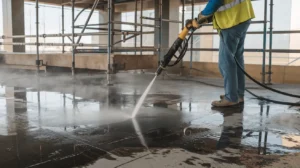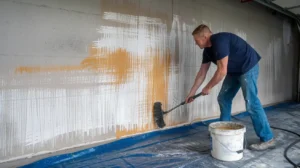Marble countertops are an elegant addition to any home, but they require proper care to maintain their beauty. One of the most common issues with marble is etching, a problem that can diminish the stone’s natural luster. If you need to remove etch from marble, this guide will walk you through the process, ensuring your countertop looks as good as new.
What Does It Mean When a Marble Countertop Etches?
When a marble countertop etches, it means the surface has been chemically altered by an acidic substance. Marble, being a calcium carbonate-based stone, reacts with acids like lemon juice, vinegar, and certain cleaning products. This reaction results in dull spots or marks on the marble surface, known as etches. Unlike stains that penetrate the stone, etches affect the stone’s surface, leaving behind a dull, lackluster area.
How Can You Tell If a Marble Countertop Is Etched?
Identifying an etch on your marble countertop is relatively straightforward. An etch appears as a dull spot or a light mark on the stone surface, where the polished finish has been compromised. These dull marks are often mistaken for stains, but they are distinctly different. Running your fingers over the area, you’ll notice that the etch feels different from the rest of the smooth, polished marble. The spot may also have a slight roughness to it, depending on the severity of the etch.
How Do You Tell the Difference Between a Marble Stain and an Etch?
It’s crucial to differentiate between a marble stain and an etch to choose the correct treatment method. A stain on marble is caused by a substance penetrating the stone and discoloring it. Stains are often darker and can be caused by wine, coffee, or oil. On the other hand, an etch is a surface-level issue where the stone has reacted with an acidic substance, leading to a dull or light mark.
To determine whether you’re dealing with a stain or an etch, try wiping the area with a damp, soft cloth. If the mark persists and feels smooth to the touch, it’s likely a stain. If the area feels rough or appears dull compared to the surrounding surface, you’re likely dealing with an etch.
Can Etching Be Removed From Marble Countertops?
The good news is that etching can be removed from marble countertops. The process requires careful attention and the right products to restore the stone’s polished finish. Depending on the severity of the etch, you may need to use a marble polishing powder, an etch remover, or, in more severe cases, seek professional help.
What’s the Best Way to Remove the Etching From My Marble Countertop?
To remove etch from marble, you can follow these steps:
Assess the Etch
First, examine the etch on your marble countertop. If the damage is light, you can usually fix it yourself using home remedies. However, if the etch is deep and more severe, it might need professional repair. Accurately assessing the etch will help you decide the best course of action to restore your marble’s surface.
Use Marble Polishing Powder
To fix light etches on marble, marble polishing powder is a good option. Start by sprinkling the powder on the etched spot. Add a few drops of water to make a paste. Then, use a soft cloth to gently rub the area in a circular motion.
This method helps to restore the marble’s smooth, polished surface, making the etch less visible and bringing back the stone’s original shine. Make sure to work carefully and follow up with a clean, dry cloth to remove any residue.
Try Baking Soda
To address minor etching on marble, you can use baking soda as an alternative to marble polishing powder. Create a paste by mixing baking soda with water. Apply this paste to the etched area and gently rub it in using a soft cloth or sponge. The mild abrasiveness of baking soda helps to buff out the etch marks without scratching or damaging the marble surface.
After rubbing, rinse the area with water and dry it thoroughly to prevent any residue from dulling the finish. This method is effective for light etching and can restore the marble’s smooth appearance.
Use a Commercial Etch Remover
A commercial etch remover is a product specifically designed to repair marble surfaces that have been damaged by etching, which is often caused by acidic substances. To use it, first, clean the affected area thoroughly.
Then, apply the etch remover according to the product’s instructions, which typically involve rubbing the solution into the etched spot using a soft cloth or pad. Allow the product to work for the recommended time, then buff the area to restore the marble’s shine. Always follow the manufacturer’s guidelines for the best results and to avoid further damage.
Buff the Surface
After you’ve removed the etch from your marble countertop, it’s important to buff the surface. Take a clean, dry cloth and gently rub it over the affected area. This process helps to restore the marble’s original shine and smoothness. Buffing eliminates any residual haze left behind from the etch removal. It also ensures that the stone surface looks even and polished.
By using a soft cloth, you prevent scratching the marble. This step enhances the overall appearance of the countertop. Regular buffing helps maintain the marble’s luster. It also makes sure that the etch is completely invisible. Finally, proper buffing keeps your marble looking pristine and well-maintained.
Professional Help
If your marble countertop has severe etching or you’re unsure about DIY methods, hiring a professional is a good option. Stone restoration specialists have the advanced tools and skills needed to handle deep etches effectively. They can assess the damage and use specialized techniques to restore your marble to its original condition.
Professionals can provide a more thorough and lasting solution compared to DIY methods. They also help avoid potential mistakes that could worsen the damage. Investing in expert help ensures that your marble countertop looks its best.
How Can I Prevent Etching From My Marble Countertop?
Preventing etching on your marble countertop is key to maintaining its beauty. Here are some tips to help you avoid future etches:
Use Coasters and Trays
Using coasters under glasses prevents stains and damage from acidic beverages like lemon juice and wine. Coasters create a barrier between the drink and the surface, reducing the risk of etching and discoloration.
Trays are useful for catching spills and splatters, protecting your countertops from unwanted messes. Regularly using these items helps maintain the integrity and appearance of your surfaces. Keep coasters and trays handy to ensure your countertops stay in excellent condition.
Avoid Acidic Substances
To protect your marble countertop, steer clear of acidic substances like vinegar, citrus fruits, and harsh cleaners. These can damage the marble by causing etching. If an acidic spill occurs, clean it up right away with a soft cloth. Prompt action helps maintain your countertop’s appearance and longevity.
Use a pH-Neutral Cleaner
To clean your marble countertop, use a pH-neutral cleaner designed for natural stone. This type of cleaner is gentle and won’t interact with the marble’s calcium carbonate. By avoiding reactions that could lead to etching, you maintain the marble’s appearance. Always choose products labeled as safe for stone surfaces. This ensures effective cleaning while preserving the stone’s integrity.
Seal Your Marble Countertop
Sealing your marble countertop regularly adds a protective layer against etching. A good marble sealer creates a barrier between the stone and acidic substances. This helps prevent damage from spills and stains. To maintain protection, reapply the sealer as recommended by the manufacturer. Regular sealing extends the lifespan and preserves the beauty of your marble countertop.
How Do I Know When It’s Time to Reseal My Marble Countertop?
Resealing your marble countertop is an essential part of its maintenance. But how do you know when it’s time to reseal? Here are some signs:
Water Absorption
If water no longer beads up on the surface of your marble countertop and instead soaks into the stone, it’s time to reseal. This indicates that the previous seal has worn off, leaving the stone vulnerable to etching and staining.
Increased Staining or Etching
If you notice that your countertop is becoming more susceptible to staining or etching, it might be due for a reseal. A fresh seal can help prevent these issues by providing a protective barrier.
Fading Shine
Over time, the polished finish of your marble countertop may start to fade, indicating that the sealant is wearing off. Resealing can help restore the shine and protect the stone surface.
Continue Your Countertop’s Journey With Stone Sealer
Maintaining the beauty of your marble countertop is an ongoing process, but with the right care, it can continue to be a stunning feature in your home for years to come. If you ever need professional help or more tips on how to keep your marble surfaces in top condition, don’t hesitate to reach out. At Stone Sealer, our experts are here to assist you with all your marble maintenance needs.
Conclusion
Etching on a marble countertop can be a frustrating issue, but it’s one that can be resolved with the right approach. By understanding what causes etching, how to identify it, and the best methods for removing it, you can keep your marble surfaces looking pristine.
Remember to prevent future etching by using the proper care techniques, and always reseal your countertop when necessary to maintain its polished finish. With these steps, your marble countertop will remain a beautiful and durable feature in your home.






